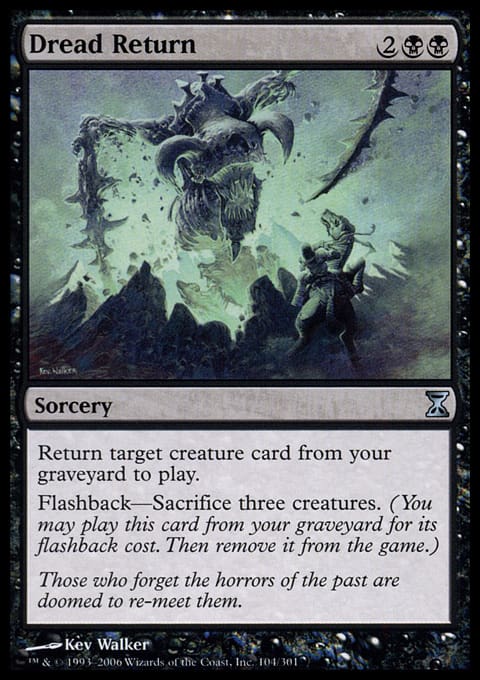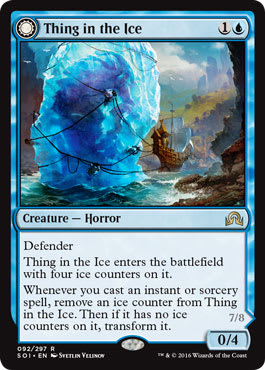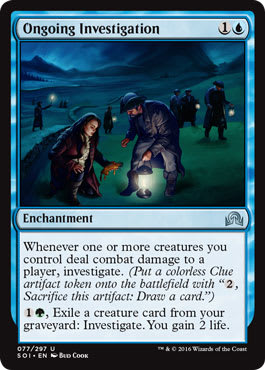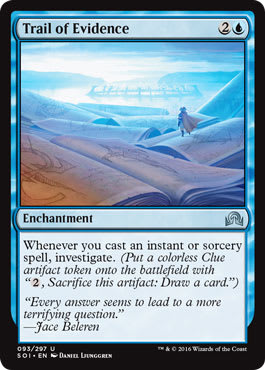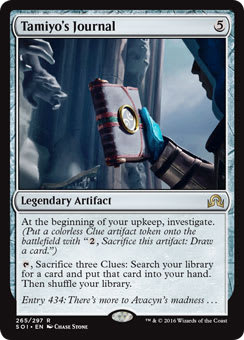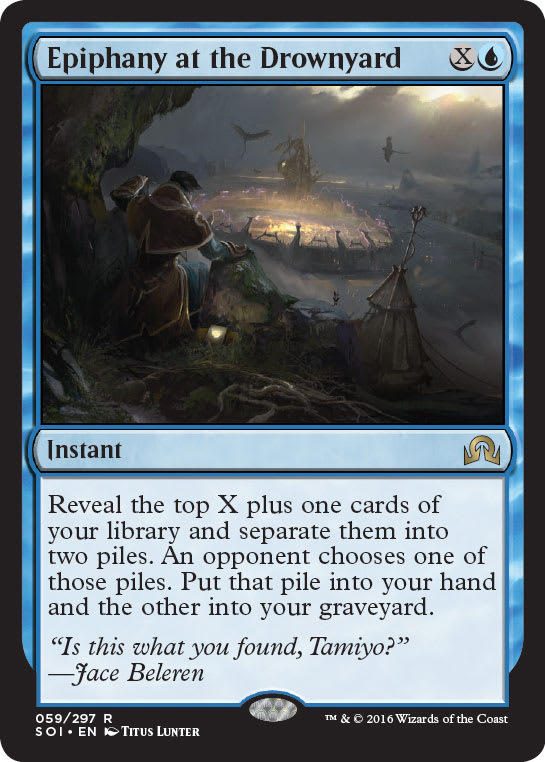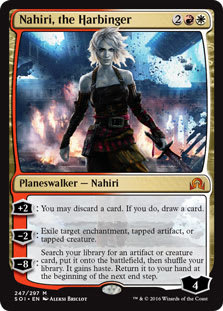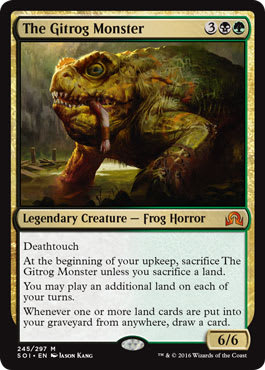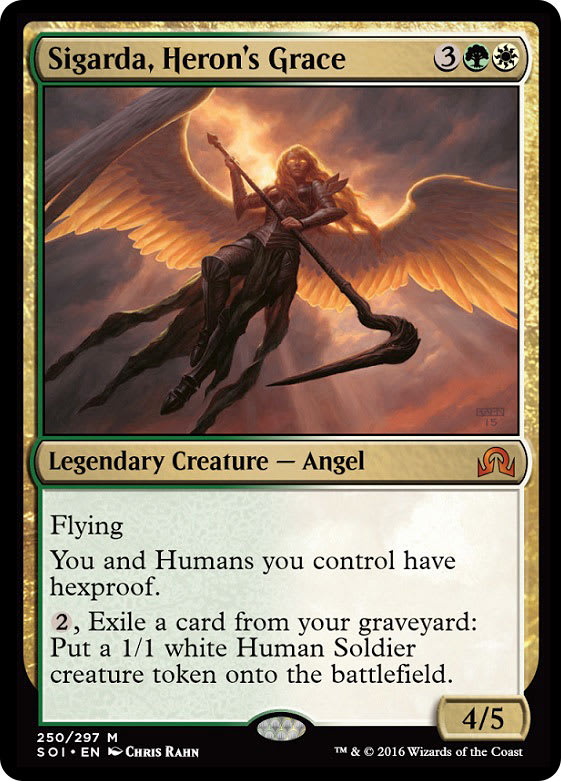It’s difficult to describe the emotions of set-release time in the Vintage world. On one hand, Vintage players are as excited as any other Magic: The Gathering players to see what new goodies Wizards has in store for us. Big creatures and new abilities, splashy mythic spells, even simple removal pop up on the radar and endure constant debate as people decide what makes the cut in the game’s oldest and most powerful format. On the other hand, we realize that Wizards doesn’t really design cards with eternal formats in mind, so of the hundreds of new cards that debut each year, very few make it into Vintage decks, and fewer still take on a lasting role. (Those that do, though . . . !)
I always try to be bullish yet realistic. Talking cards up makes a better article than, “Here are all the cards that are better than this new one, along with several more reasons why it won’t be played,” for eight or ten new cards. That’s harder with some sets than others, but Shadows over Innistrad has some interesting options. Plus, following my card reviews, I have another big news item.
There’s Something in My Drink
In an earlier article, I listed a few things I look for regarding Vintage playability:
- Blue and black spells that cost 1 or 2 mana
- Artifacts in general, especially those that cost 1 or 3 mana
- Oath of Druids, Tinker, and Dread Return targets (that is, big creatures or expensive ones with great abilities)
- Spell-based mana acceleration
- Planeswalkers
- Good new counterspells and hate cards for artifacts and graveyards particularly. This also includes hate-bears-style creatures.
- Draw spells and tutors
I didn’t mention one important type of card, though: “cards that reward you for playing Magic.”
Vintage has a long history of these cards, going back to Yawgmoth's Will and Quirion Dryad, and more recently with Tarmogoyf (which I realize is now approaching ten years old), Young Pyromancer, and Monastery Mentor. These are cards that become better as the game goes on, simply because you’re playing spells and drawing cards and generally doing things you would be doing anyway. Yawgmoth's Will, for example, isn’t always a great opening-hand card, but it’s good on turn three or four and awesome on turn eight. Then, you have the opportunity to replay all the things you’ve done before and just bury your opponent in advantage if not win outright. Pyromancer and Mentor similarly will make tokens and grow them just for playing counterspells and Preordaining, whether or not you press that advantage.
Thing in the Ice is similar; a lot of decks will benefit simply by having a blue 2-drop with the potential to turn into a 7/8 Horror in one or two turns. The formula is almost literally:
Step 1: Play Thing in the Ice.
Step 2: ???
Step 3: Profit!
A 2-mana blue creature is the perfect vehicle for this. It compares well with Tarmogoyf but is easier to slip into a deck because most decks already run blue. At 1 mana, Thing risks being Mental Misstepped, and at 3 or more mana, it would take too long to put into play and start thawing. The 0/4 defender is unremarkable—it blocks a few things, but not Lodestone Golem—but the 7/8 Awoken Horror is decidedly big. It tangles well with everything in the format, and the transformation-trigger ability will work on most of the common creatures in the format except for Ichorid and Phyrexian Revoker.
I look forward to seeing Thing in future decklists, possibly resembling this one:
U/R Pyromancer Thing ? Vintage | Nat Moes
- Lands (16)
- 4 Scalding Tarn
- 4 Misty Rainforest
- 3 Volcanic Island
- 3 Island
- 1 Snow-Covered Island
- 1 Mountain
- Planeswalkers (2)
- 2 Dack Fayden
- Spells (31)
- 4 Force of Will
- 4 Preordain
- 3 Gush
- 3 Lightning Bolt
- 2 Mental Misstep
- 1 Ancestral Recall
- 1 Time Walk
- 1 Brainstorm
- 1 Ponder
- 1 Treasure Cruise
- 1 Dig Through Time
- 2 Flusterstorm
- 1 Steel Sabotage
- 2 Spell Pierce
- 1 Mystical Tutor
- 1 Mox Ruby
- 1 Mox Sapphire
- 1 Black Lotus
- Creatures (11)
- 4 Young Pyromancer
- 3 Thing in the Ice
- 2 Vendilion Clique
- 2 Snapcaster Mage
- Sideboard (15)
- 3 Ravenous Trap
- 3 Grafdigger's Cage
- 1 Surgical Extraction
- 1 Tormod's Crypt
- 2 Mindbreak Trap
- 3 Ingot Chewer
- 1 Shattering Spree
- 1 Red Elemental Blast
This is based on a RUG Pyromancer list I did well with at Gen Con a few years ago, but now it cuts green entirely to simplify the mana base. Here, as with the original list that included Tarmogoyf, Thing in the Ice, or rather, Awoken Horror, has an important role in the creature package. It holds the ground against big creatures, allowing Elemental tokens or Vendilion Clique to swing for the win. Against smaller attackers (any that aren’t bounced when it transforms, that is), Elemental tokens can stave off the swarm while Awoken Horror bashes.
Investigating Options
Investigate as an add-on ability for spells is probably too slow and expensive for Vintage. In most cases, the benefit of potentially drawing a card later often makes an effect—whatever it is—cost too much compared to the vanilla version. The few cards with investigate that hold some interest are, again, ones that reward you for playing Magic.
Ongoing Investigation and Trail of Evidence have the benefit of being blue and triggering multiple times for various things: Ongoing Investigation gives a Clue for creatures dealing combat damage to players; and Trail of Evidence does the same for playing instants or sorceries. Frankly, they do nothing in the short term, but that makes them low-risk. If the game goes long, their Clues could potentially add up to big advantages. Particularly, I could see Trail of Evidence in a Landstill-type control deck as Standstill number five or six as a way to stay in the game. I also think Jace, the Mind Sculptor already fills that role well with benefits, though.
Tamiyo's Journal could be played off Mishra's Workshop with the idea of tutoring up a haymaker in three turns. On its own, that’s probably not as good as Kuldotha Forgemaster, but again, it’s low-investment. Artifact Clues also have other uses, such as tapping to Tangle Wire or sacrificing to the aforementioned Forgemaster or Smokestack. If there’s a faster, easier colorless way to generate Clues in Eldritch Moon, building a 5-mana artifact Demonic Tutor might be worth considering.
Epiphany! at the Disco
If Epiphany at the Drownyard is going to be successful in Vintage, it will only be because of its instant speed and flexibility. At
It’s easy to say that, because your opponent makes the final decision in the Drownyard, you always gain the worse pile, but it’s more complicated than that. Bluffing and opportunities to exploit hidden information abound in Vintage. Does she really have the win or is she just looking for an answer? Do I really want to bin that Worldgorger Dragon? There are also plenty of one-sided piles that pop up in Vintage. Would your opponent rather give you the Yawgmoth's Will or the four other cards?
I like this card a lot. It has some obvious weaknesses compared to some cards already mentioned, but I think it merits some testing and might even see some Top 8s. Because of its mana cost, it fits into a lot of different shells, however, so it will take some effort to determine whether it’s the shell that’s winning or Epiphany itself.
Harbinger of What, I Ask
I like Nahiri, the Harbinger as an addition to the Planeswalker fold. Her mana cost fits with many current Vintage strategies, being sufficiently playable out of U/r/w Mentor and Bomberman decks as well as Naya and Mardu aggro control decks. She filters cards, deals with troublesome permanents (including, notably, Oath of Druids), and survives Lightning Bolt. More important, she wins the game when her ultimate resolves, producing Blightsteel Colossus or Emrakul, the Aeons Torn, with haste.
Vintage for the past few months has been a relatively slow format: Dark Petition Storm is popular but isn’t usually a turn-one killer, and other blue decks are content to set up creature-based wins with Young Pyromancer or Monastery Mentor. As a result, in these matchups, Planeswalkers can take larger roles as their abilities can take over a longer game. (Even Chandra, Flamecaller has been seeing play in U/R Blue Moon control decks since she filters cards and cleans up token strategies.) Nahiri could make similar inroads if the proper shell is found for her.
Mardu Nahiri ? Vintage | Nat Moes and Jake Hilty
- Planeswalkers (2)
- 2 Nahiri, the Harbinger
- Creatures (32)
- 1 Blightsteel Colossus
- 4 Dark Confidant
- 4 Simian Spirit Guide
- 2 Elvish Spirit Guide
- 4 Deathrite Shaman
- 4 Thalia, Guardian of Thraben
- 4 Phyrexian Revoker
- 2 Hammer Mage
- 3 Containment Priest
- 2 Goblin Sharpshooter
- 2 Goblin Welder
- Spells (8)
- 1 Lotus Petal
- 3 Stony Silence
- 1 Wear // Tear
- 1 Swords to Plowshares
- 1 Demonic Tutor
- 1 Vampiric Tutor
- Lands (18)
- 3 Marsh Flats
- 2 Arid Mesa
- 3 Plateau
- 3 Scrubland
- 1 Savannah
- 3 Wasteland
- 1 Strip Mine
- 2 Plains
- Sideboard (15)
- 3 Ingot Chewer
- 1 Wasteland
- 2 Path to Exile
- 2 Sulfur Elemental
- 1 Stony Silence
- 4 Leyline of the Void
- 2 Aegis of the Gods
Seriously, Nahiri’s ability is basically Tinker, but you sometimes need to find a hasty Hammer Mage.
And the Rest
Of course, since everything is legal in Vintage, all Shadows over Innistrad cards are technically “playable.” Some mad brewer could build a deck around Harness the Storm or Brain in a Jar, each of which has combo potential, even if it takes effort to set up and navigate through Vintage’s challenges. Brain in a Jar, for example, combos well with Voltaic Key for multiple activations per turn and allows end-of-turn Day's Undoing, Tendrils of Agony, or Empty the Warrens.
Invasive Surgery, Engulf the Shore, Declaration in Stone, and Anguished Unmaking are all reasonable utility spells, but reasonable utility in Vintage means comparison against every similar card in the history of Magic. Invasive Surgery is strictly better than Envelop, but Envelop isn’t played over Flusterstorm or Spell Pierce, for example. Of these, I think Declaration in Stone has the best chance of being played, as an answer to token strategies that would also be reasonable to cast against a Lodestone Golem or two as well.
For big creatures, Archangel Avacyn, The Gitrog Monster, and Sigarda, Heron's Grace all have roles they could fill. Avacyn could be an aggro finisher or sideboard card in something like a Blue Angels, Miracles, or Bomberman, where flash would fit well into the control strategy playing things at end of turn. The Frog allows Dredge to see its whole deck, but I’m not sure if that’s good or just foolhardy, and at 5 mana, it probably won’t compete with Tasigur, the Golden Fang in BUG control or aggro decks. Sigarda, however, is hilarious in the Oath of Druids mirror; with Sigarda in play, your opponent can’t target you and thus can’t trigger Oath, no matter how many Humans you make.
At the Beginning of Your Next Main Phase . . .
Shadows over Innistrad is going to be the newest, best thing in Magic for a while, and I’m excited to share my thoughts on its cards. I’m even more excited to share the news that The Mana Drain, is up and running as Vintage’s primary resource for strategy, discussion, tournament announcements, and more.
Longtime Vintage aficionado Andy “Brass Man” Probasco purchased the site from its previous owners and has put in a lot of work to redesign everything. It even looks great on mobile. There’s still work to be done, and Andy is taking suggestions on what would be most useful, especially for players just getting into the format. If you have an interest in participating in the Vintage community—whether playing online or off, with or without playtest cards, using blue cards or artifacts—I very much recommend creating an account there and joining in.
At the very least, you can upvote my articles there when I post them!
Thanks for reading,
Nat Moes














